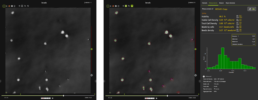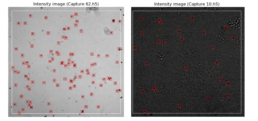Beads for T-cell activation

The iLine F and qMod can be used for, on-line, real-time monitoring during the expansion phase of the T cells and as a QC tool to check the residual concentration of beads in the release batch, respectively.
T-cell receptor engagement, with accompanying co-stimulatory signals, control the level of activation and functional potential of individual T cells. This can be further manipulated by various ex vivo methods to trigger a physiological activation and expansion of human T cells for potential clinical applications. The anti-CD3/anti-CD28 beads provide primary and co-stimulatory signals, optimized for efficient T-cell activation and expansion, these beads remain present for the whole expansion process before being removed and, therefore, must be accurately differentiated from cells or cell debris over the culture. The presence of these beads may impact the cell count, which is why the OsOne software associated with our machine learning platform can segment and count the beads separately from the cells thanks to their very specific holographic fingerprint (see purple dots in the images below).
This allows the total cell count and cell viability to be unaffected.
Case study 1
Ovizio’s qMod quantitative camera can be used to count the number of beads left in your release batch, within the CAR-T or TCR-T cell process, without having to dilute the sample or lyse the cells.
Here below are some examples of detection/segmentation of lysed and unlysed, undiluted samples of CAR-T cells with CD3/CD28 beads left.
Case study 2
Detecting morphology changes in iKNOBEADS® activated-T cells using holographic fingerprinting (joint poster with Industrial Technology Research Institute (ITRI), Taiwan.)
ITRI iKNOBEADS® are the world’s first magnetic microparticles with tailorable sizes and shapes. Their unique morphology with bioinspired knobs and rough surface provides a potential for biochemical applications and, are the high efficient materials for ex vivo activation and expansion of immune cells for immunotherapy. In this study, the customers used the Ovizio qMod holographic camera, combined to a Leica DM IRB microscope. Human T cells were cultivated on 24-well plates and activated with iKNOBEADS®.
In a dye-free and fast image acquisition/computation set-up, the qMod holographic camera and its associated OsOne Software provided:
- Detection, classification and discrimination of iKNOBEADS® versus Hu T cells.
- Detection and classification of activated-T cells by developing a machine learning model, Neural Network, to track the striking change of the T cells size over time.
Need any technical help?
Please email us at support@ovizio.com
T: +32 2 600 50 90
E: info@ovizio.com
Ovizio Imaging Systems NV/SA
Av. Kersbeek 306
1180 Uccle / Belgium
Website by Monkeys not Donkeys



